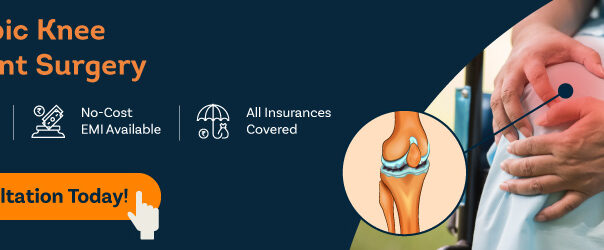![]() Views: 892
Views: 892
What is the Difference Between Robotic and Traditional Knee Replacement
Both methods aim to alleviate pain and improve knee function, but there are important differences between them that patients should consider. In this blog, we will explore the differences between robotic and traditional knee replacement surgery, including the benefits and drawbacks of each method.
Dedicated Support at Every Step!
Our Doctors are available 24 hours a day, 7 days a week to help you!
Table of Contents
Robotic Vs Traditional Knee Replacement
Knee replacement surgery is a commonly performed procedure for the treatment of chronic knee pain caused by arthritis or other degenerative conditions. With advancements in technology, robotic knee replacement surgery has emerged as an advanced and more precise surgical technique for knee replacement. Robotic knee replacement uses computer-assisted technology to guide the surgeon during the procedure, while traditional knee replacement is performed manually by the surgeon. Both methods aim to alleviate pain and improve knee function, but there are important differences between them that patients should consider. In this blog, we will explore the differences between robotic and traditional knee replacement surgery, including the benefits and drawbacks of each method.
No Cost EMI, Hassle-free Insurance Approval
When Robotic Knee Replacement is Suggested?
Robotic knee replacement surgery may be suggested for patients with severe knee arthritis or other knee conditions that have not responded to non-surgical treatments. This surgical procedure may be recommended when the knee pain and stiffness affect the patient’s daily activities and quality of life.
Robotic knee replacement surgery uses a specialized robotic arm to help the surgeon with the procedure. The robotic arm is controlled by the surgeon, who uses it to create a 3D map of the patient’s knee joint. This map allows the surgeon to make precise cuts and placements of the knee implant, leading to better alignment and a more natural-feeling joint.
Some of the benefits of robotic knee replacement surgery may include smaller incisions, less blood loss, faster recovery, and potentially better outcomes in terms of joint function and long-term implant survival.
Ultimately, the decision to undergo robotic knee replacement surgery will depend on a patient’s individual condition and their goals for treatment. It is important to discuss all available treatment options with your doctor to determine the best course of action for your knee condition.
What are the Risks and Benefits of Robotic Knee Replacement?
Like any surgical procedure, robotic knee replacement surgery has both risks and benefits. Some potential risks of robotic knee replacement surgery include:
- Infection: As with any surgery, there is a risk of infection following robotic knee replacement.
- Blood clots: Blood clots can form in the leg veins after surgery, which can be dangerous if they travel to the lungs.
- Nerve or blood vessel damage: The robotic arm used during surgery can potentially cause damage to nearby nerves or blood vessels.
- Implant failure: Although rare, the implant may fail or loosen over time, requiring revision surgery.
- Anesthesia complications: There is always a risk of complications related to anesthesia.
Some benefits of robotic knee replacement surgery may include:
- More precise implant placement: The robotic arm used during surgery allows for more precise implant placement, potentially leading to better implant alignment and stability.
- Smaller incisions: Robotic surgery typically involves smaller incisions than traditional knee replacement surgery, which may lead to less blood loss and faster recovery.
- Reduced pain and improved function: Many patients report reduced pain and improved knee function following robotic knee replacement surgery.
- Shorter hospital stays: Patients may be able to go home sooner after robotic knee replacement surgery, compared to traditional knee replacement surgery, potentially reducing hospital costs.
- Improved long-term outcomes: Studies have shown that patients who undergo robotic knee replacement may have better long-term outcomes and implant survival rates than those who undergo traditional knee replacement surgery.
It is important to discuss the potential risks and benefits of robotic knee replacement surgery with your doctor to determine whether it is the right option for you.
Recovery and Success Rate of Robotic Knee Replacement
Recovery and success rates of robotic knee replacement surgery can vary from patient to patient and depend on various factors such as age, overall health, the severity of the knee condition, and adherence to post-operative rehabilitation protocols.
In general, recovery from robotic knee replacement surgery may be faster than traditional knee replacement surgery, as the procedure typically involves smaller incisions, less blood loss, and more precise implant placement. Patients may be able to begin walking with assistance and engaging in physical therapy soon after surgery, which can help improve recovery time and overall outcomes.
The success rate of robotic knee replacement surgery is generally high. Studies have shown that patients who undergo robotic knee replacement have reported improved joint function, reduced pain, and increased mobility. Additionally, robotic surgery may lead to better implant alignment, potentially reducing the risk of implant loosening, instability, or dislocation over time.
However, as with any surgical procedure, there are potential risks and complications associated with robotic knee replacement, such as infection, blood clots, nerve or blood vessel damage, and implant failure. Patients should discuss these risks with their surgeon before undergoing the procedure.
Overall, the success rate and recovery time of robotic knee replacement surgery may vary depending on individual circumstances, but it has been shown to be a viable and effective option for many patients with knee conditions.
When Traditional Knee Replacement Surgery is Suggested?
Traditional knee replacement surgery may be suggested for patients with severe knee arthritis or other knee conditions that have not responded to non-surgical treatments such as physical therapy, medication, or injections.
In this surgical procedure, the surgeon makes an incision in the knee to access the joint and removes the damaged or diseased parts of the knee. Then, a knee implant made of metal, plastic, or ceramic materials is placed in the knee joint to replace the damaged tissue.
Traditional knee replacement surgery is usually recommended when knee pain and stiffness significantly affect a patient’s daily activities and quality of life. It may be particularly suitable for older patients or those with additional medical conditions that may increase the risks associated with robotic surgery.
Some of the potential benefits of traditional knee replacement surgery may include improved joint function, reduced pain, and increased mobility. However, it is important to note that the recovery period after traditional knee replacement surgery may be longer than with robotic knee surgery, and there may be a higher risk of complications, such as infection or blood clots.
Ultimately, the decision to undergo traditional knee replacement surgery will depend on a patient’s individual condition, medical history, and goals for treatment. It is important to discuss all available treatment options with your doctor to determine the best course of action for your knee condition.
Risks and Benefits of Traditional Knee Replacement Surgery
Traditional knee replacement surgery is a procedure in which damaged or worn-out portions of the knee joint are removed and replaced with artificial components. As with any surgical procedure, there are both risks and benefits associated with traditional knee replacement surgery.
Benefits of Traditional Knee Replacement Surgery:
- Pain relief: One of the most significant benefits of knee replacement surgery is that it can relieve the chronic pain and discomfort associated with a damaged knee joint.
- Improved mobility: The surgery can improve mobility and help patients return to their normal activities, such as walking, climbing stairs, and exercising.
- Enhanced quality of life: By eliminating the pain and discomfort caused by the damaged knee joint, the surgery can enhance the patient’s overall quality of life and increase their ability to perform daily activities.
- Improved knee function: Knee replacement surgery can also improve knee function, allowing for a better range of motion and stability.
Risks of Traditional Knee Replacement Surgery:
- Infection: There is a risk of infection following knee replacement surgery, which can be serious and require additional treatment.
- Blood clots: There is a risk of blood clots forming in the legs after surgery, which can be potentially life-threatening if they travel to the lungs.
- Implant failure: The artificial components used in knee replacement surgery can sometimes loosen or fail, requiring additional surgery to correct the issue.
- Nerve and blood vessel damage: There is a risk of nerve or blood vessel damage during surgery, which can cause numbness, tingling, or other complications.
- Rehabilitation: Following knee replacement surgery, patients are typically required to undergo rehabilitation to regain strength and mobility in the affected knee. This can be a lengthy and challenging process.
Overall, traditional knee replacement surgery can be an effective treatment option for those suffering from chronic knee pain and discomfort. However, it is essential to weigh the potential risks and benefits of the procedure carefully and discuss them with a qualified healthcare professional.
Recovery and Success Rate of Traditional Knee Replacement Surgery
Recovery and success rates following traditional knee replacement surgery can vary depending on a variety of factors, including the patient’s overall health, age, and extent of knee damage, as well as the surgical technique used and postoperative care.
Recovery:
Recovery period after traditional knee replacement surgery typically involves a hospital stay of 1-3 days, followed by a period of rehabilitation and physical therapy. Patients are encouraged to engage in range-of-motion exercises and strength-building activities to help restore mobility and strength in the affected knee. Recovery time can vary, but most patients are able to return to normal activities within 6-12 weeks following surgery.
Success Rates:
The success rate of traditional knee replacement surgery is generally high, with studies reporting success rates of over 90% in most cases. Success is defined as pain relief and improved function of the knee joint. However, success rates can be affected by various factors, such as patient age, extent of knee damage, and pre-existing medical conditions.
Overall, traditional knee replacement surgery can be an effective treatment option for those suffering from chronic knee pain and discomfort, with high success rates and a relatively low risk of complications. However, it is important for patients to carefully consider the potential risks and benefits of the procedure and discuss their options with a qualified healthcare professional.
Conclusion
In conclusion, knee replacement surgery can significantly improve the quality of life of those suffering from chronic knee pain and discomfort. While traditional knee replacement surgery has been the standard of care for many years, the advent of robotic-assisted knee replacement surgery has brought a new level of precision and accuracy to the procedure.
Ultimately, the choice between robotic knee replacement surgery and traditional knee replacement surgery depends on several factors, including the patient’s individual needs and preferences, the extent of knee damage, and the surgeon’s expertise. Patients should discuss all options with their healthcare provider to determine the best course of treatment for their specific case.
Overall, both traditional and robotic-assisted knee replacement surgery are proven to be safe and effective treatments for knee pain and discomfort. Patients should be sure to carefully weigh the potential risks and benefits of each procedure and discuss them with their healthcare provider to ensure the best possible outcome.















